
Racing for the future; championships embrace clean power for flotillas
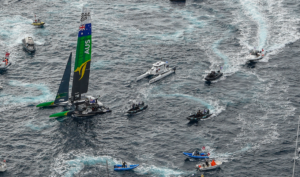
Global sailing events, from SailGP to the America’s Cup and Olympics, are setting out their sustainable credentials by developing, or utilising, clean power solutions for support vessels, choosing the best electric RIBs and hydrogen powered vessels.
As previously reported in MIN, SailGP’s chartering electric RIBs into operational roles as part of its support flotilla for the European championship legs. The range requirement for these specific roles is around 20nm, says Tom Verity who looks after the sustainability division of SailGP. He’s been in the marine world for around six months, but comes from a background rich with electric infrastructure.
Verity’s remit is to look at the travelling championship’s on-water transition. This means he’s in charge of getting the flotilla that supports each event – whether that’s hospitality, media, medical boats or more – to be powered by clean energy. When the flotilla takes to the water later this month in Plymouth (30-31 July 2022), it’ll be around 50 boats, with some locally chartered.
Ambitious clean energy targets

RS Electric Pulse
So with the target he’s set, to have a clean flotilla by 2025, Verity has his work cut out. Plus, SailGP needs to transport the absolute minimum between venues, otherwise it’ll undermine its own credentials.
Verity admits the ambition’s aggressive, but says it’s there to push the organisation and will consequently help push the sector forward.
“In the terrestrial sector there are very aggressive targets in terms of phasing out petrol and diesel. But the marine sector doesn’t have that legislation, so the timelines are a lot longer. SailGP’s set our timeline to help private enterprise push that needle of innovation.”
By this he means that the race is working with, and providing platforms to, innovative technologies that can be harnessed now and into the future. He says the marine sector is in the onset of this energy transition and it’s relying on private enterprise taking risks, innovating challenges and developing solutions.
“It’s so early on in the journey in the marine world,” Verity says. “The marine industry is 10-15 years behind terrestrial sector in terms of energy transition.
“So SailGP acts like a sandbox, where companies can bring their clean fuel solutions and test them in an environment with a very high range of requirements – we’re looking for high speed, capacity and confidence to face challenges.”
He may have only been in post for six months, but Verity is pushing forward at speed. SailGP is chartering five electric boats this year within the operational fleet in Plymouth. These boats will be out all day performing operational roles with challenging range requirements.
One of the companies being tested in Plymouth Sound National Marine Park, is RS Electric. SailGP has chartered four of the company’s electric RIBs – Pulses as they’re known. (Vita and Aqua Superpower, which provides electric charging solutions, will be there too.)
Verity says RS Electric’s Pulse is unique.
“It’s a complete product,” he says. “It’s one of the leading electric ribs out there with the pipelines and the capability to actually deliver electric ribs to the event. The credentials are fantastic, especially the way the technology performs. It’s market leading in the role that we’re chartering it into.”
That role, this time around, is for the media, who come with, literally, a lot of baggage.
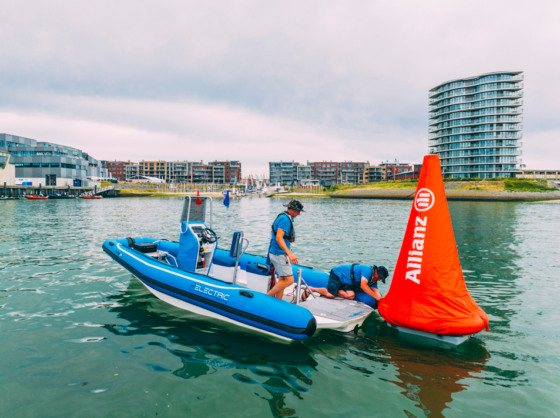
“It’s got really good deck space to accommodate the equipment needed,” says Verity. “There are high range requirements with these flotilla roles and the Pulse is very able to meet those.
“It’s a robust design, we’re very confident that it can perform in these demanding operational roles.”
The ruggedness of its design was one of the attractions – being able to stand-up to wear and tear. Verity says it excels in those capacities and that’s why SailGP’s taking the four Pulses on the European leg of its tour.
“We run the risk of local markets when we go to an event,” Verity explains. “Ideally if we could go to an event and charter locally that would be ideal as we wouldn’t have to ship boats around the world. But we’re subject to the availability of the local fleet. How quickly that moves to clean energy will affect, in some regards, how able we are to meet our targets and ambitions ourselves.”
But it’s more than the clean fuel that attracts SailGP. Verity cites RS Electric’s commitment to manufacturing the boats with sustainability at their core.
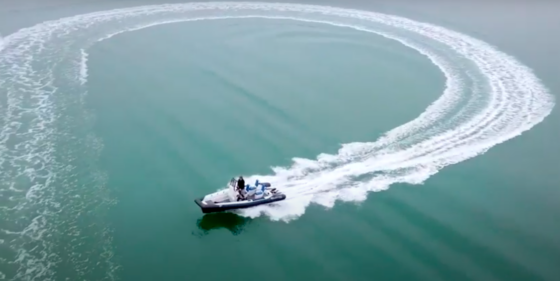
“That really resonates with the championship,” he says.
Providing the best electric RIBs with a showcase
While SailGP will also be taking an owned asset, which has been clean-energy retro-fitted to Plymouth for testing, Verity says the event will add a lot of value to all the other clean energy providers.
“SailGP provides a link between the marine sector and consumer awareness,” he says. “People have a front of mind appreciation of the need to transition their car towards clean energy. But transitioning the marine sector isn’t front of their minds. SailGP can connect the general public with solutions that are helping to decrease carbon emissions of the marine industry. The events provide platforms for existing technologies to meet with the general public and also tell the story of the importance of the transition for the marine sector.
“It’s a place for electric technologies to showcase operability.”
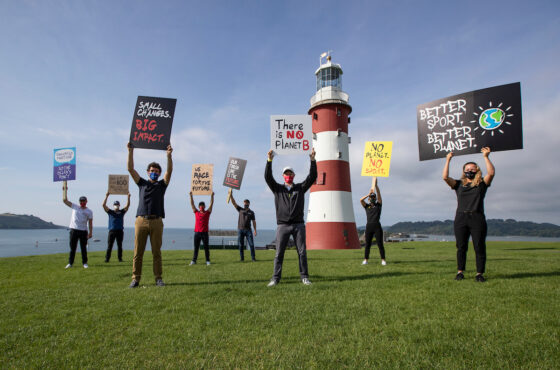
He’s looking forward to showing the racing teams what the Pulse can do, not only because he’s a fan of the RIB, but also as the teams are all part of a recently announced Impact League (image shows athletes from the league in Plymouth). This runs parallel to the championship and, basically, ranks the teams on how well they’re performing in a sustainable context. The idea could just set the standard for washing out the greenwashers.
“Exhibiting the electric Pulse to the teams,” Verity says, “and saying electric solutions can do what you need in a cleaner and better way, will help showcase their operability.”
America’s Cup looks to hydrogen
The America’s Cup, an event with technology at its core, is at the pinnacle of international sailing. As such, says Nick Burridge (Chase Zero operations coordinator), it “has an opportunity to lead by example and sustainability is clearly one avenue that the event can show the way.”
It’s decided to invest in a hydrogen powered future, for the America’s Cup. Burridge says Emirates Team New Zealand (ETNZ) did some rough calculations for a purely electric boat, but that it was evident early on that it couldn’t meet the range requirements of the chase boats on the water each day (a full day following an AC75).
ETNZ says it has run its recently developed Chase Zero for a total 36 hours of motoring, covering over 1,042km (562.6 nautical miles) on the water, with the only emissions of its operations being pure water. This was developed to make the most of the opportunity to ‘shape’ the direction of the next event.
“One specific area that has a lot of room for improvement was around the fuel consumption of the chase boats that follow the AC75’s around each day,” says Burridge. “However, from experience we know that batteries alone would not be able to do the job due to the long periods at sea.
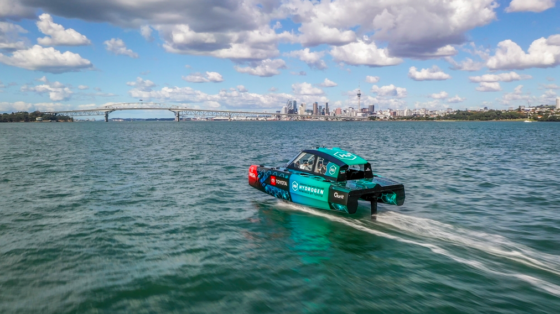
“Hydrogen is obviously a new technology that is making headway in the motor vehicle industry, but it hasn’t really made any headway into the marine sector yet. So this is a prime opportunity to try to push hydrogen technology in the America’s Cup and prove it as a successful use case that will have a significant impact on the emissions of the teams in AC37 but also have a significant trickle-down effect on the global marine industry.
“Hydrogen has a much higher energy density than the current battery technology, and batteries are unsuitable in any marine applications that need power for more than a couple of hours – not least in long distance marine transport. To extract electrical power from hydrogen you need a fuel cell onboard; this electrical power then drives motors that propel the vessel. Fuel cell technology is growing daily, and we see huge potential for the high energy and medium to long-distance applications where the mass of batteries to store the equivalent energy required makes it unfeasible.”
Mutually beneficial solutions for clean energy
SailGP has an RFP (request for proposal) out currently for support boat development. This isn’t just looking at the propulsion side, but also at the end-to-end manufacture of the boats themselves, and the sustainability of the full life cycle. The RFP is described as “agnostic of technology”. SailGP will consider electric, hydrogen or hybrid.
Like SailGP, the Parisian Olympic and Paralympic committee announced that its games would be sustainable and that they’re aiming for 100% renewable energy.
“It’s great when bodies like the Olympics with such a big footprint and viewership put out statements and ambitions like that,” Verity says. “We’re engaged with World Sailing, who work with the Olympics and their Challenge 24 committee. So we’re really keen, when we’re working with vendors and developing new solutions, and developing new technologies for ourselves, to ensure that people like the Olympics are brought in on that conversation. We’re making sure that any solutions we develop, or we bring to site, are mutually beneficial for us all.”
Read about all the latest developments with electric boats and marine innovations.
SailGP images courtesy of Ian Roman, Jon Buckle, Thomas Lovelock. America’s Cup images courtesy of ETNZ.
